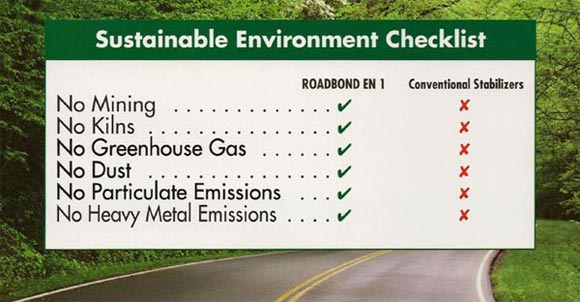ROADBOND EN 1™ Is Used to Encapsulate Drill Cuttings
ROADBOND EN 1™ Environmental Advantages and LEED Credit
ROADBOND EN 1™ is A Green, Earth Friendly Product

Growth and construction have a profound impact on our environment, economy and productivity. ROADBOND EN 1™ is a well established, proven product that addresses some of the important challenges of our time. These challenges include the reduction of:
• Construction use of water and natural resources
• Greenhouse gas emissions
• Dependence on non-sustainable sources of energy
• Carbon footprint of projects
A Sustainable Environment
 ROADBOND EN 1™ contributes to a sustainable environment in a number of important ways and may qualify for LEED™ credit under “Innovation in Design.” ROADBOND EN 1™ uses less water, energy and lowers C02 emissions and because it is concentrated:
ROADBOND EN 1™ contributes to a sustainable environment in a number of important ways and may qualify for LEED™ credit under “Innovation in Design.” ROADBOND EN 1™ uses less water, energy and lowers C02 emissions and because it is concentrated:
One 5-gallon pail replaces 12 tons of lime (1 1/3 truck loads)
For instance, a 54,000 square yard project requires 300 gallons of ROADBOND EN 1™ or 730 tons of lime. (80 truck-loads or more) In this scenario, the use of ROADBOND EN 1™:
Saves Water:
• ROADBOND EN 1™ uses 60,000 gallons of water
• Lime requires 405,000 gallons of water
• 675% less water
Saves Energy:
• ROADBOND EN 1™ saves the energy consumed by 960 homes in one month
• Lime consumes 2,000 kwh of electricity per ton produced 3
• Average home uses 936 kWh of electricity per month 5
Reduces green house gas:
• ROADBOND EN 1™ offsets C02 emissions by 936 tons 2
• That’s like parking 1,650 cars for 1 month 6
• And not driving 1.7 million miles 6
• Or planting 312 fast growing pine trees 7
Environmental Impact of Conventional Stabilizers
Conventional stabilizers are high environmental impact products that are principally derived from the mining and calcination of limestone. This process requires limestone to be fired in kilns at over 1200 degrees C and for every ton of lime produced:
• Over 8 tons of limestone must be quarried 1
• 2000 kwh of energy is consumed 2
• 1.3 tons of C02 is emitted 3
• Also, the EPA has identified the lime manufacturing industry as a major source of hazardous air pollutant emissions. 4
These emissions include:
• Hydrogen chloride
• Arsenic
• Chromium
• Lead
• Mercury
Notes: (1) Dept of Energy Report “Energy and Environmental Profile of the Mining Industry” (2) Climate Change 2007, Mitigation of Climate Change, Bert Metz, Intergovernmental Panel on Climate Change – (3) Miner and Upton, 2002 – (4) Federal Register / Vol. 69, No.2 / Monday, January 5, 2004 / Rules and Regulations) – (5) Energy Information Administration – (6) EPA 420-F-00-013 – (7) GreaterGood.org
